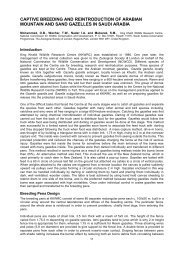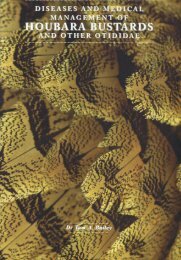His Highness Sheikh Zayed bin Sultan Al Nahyan - Wildlife Middle ...
His Highness Sheikh Zayed bin Sultan Al Nahyan - Wildlife Middle ...
His Highness Sheikh Zayed bin Sultan Al Nahyan - Wildlife Middle ...
You also want an ePaper? Increase the reach of your titles
YUMPU automatically turns print PDFs into web optimized ePapers that Google loves.
nest on cliffs along the Crimean mountains and the Black<br />
Sea coast. It is relatively stable on a level of 40-50 pairs<br />
(Prokopenko, 1986; Klestov and Tsvelykh, 1999; Vetrov,<br />
2001). East of the Crimea along the Azov Sea northern coast<br />
about 10 isolated pairs still occur (Beskaravayniy, 1996,<br />
2001; Andryushchenko et al., 1998; Vetrov, 2001).<br />
Therefore, a total Ukrainian population of the Saker<br />
consisted of 120-140 pairs at the end of 20 th century<br />
(Vetrov, 2001), but it is likely to decline to less than 100<br />
pairs (V.Vetrov and Yu. Milobog, personal comm.).<br />
The Saker population decline in European Russia<br />
was previously discussed and showed that soon there will<br />
be nothing to discuss, because the Saker has almost<br />
disappeared there. Between the Don and Volga rivers the<br />
last breeding areas were deserted in 1990s. Some sightings<br />
of sakers in summer time (but not active nests) have been<br />
recorded at the North Caucasus: above the Ergeny Hills<br />
along an administrative line between the Rostov region and<br />
Kalmykia (Belik, 1999) and in Dagestan, where 5-6 pairs<br />
are assumed to live (Vilkov, 2001). East of the Volga river<br />
the last nesting pairs continue to disappear. For example, in<br />
the well studied Saratov region some areas like the Dyakov<br />
forest in 1930s were densely inhabited by Sakers with only<br />
1-2 km apart (Volchanetsky and Yaltsev 1934). However, at<br />
the end of 1990s the Saratov region (101,000 km 2) had from<br />
10-15 to 35-40 breeding pairs (Moseikin, 1991; Zavyalov et<br />
al., 1999), while at the very beginning of the 21 st century<br />
only 5-10 pairs remained (Antonchikov and Piskunov<br />
2003). The total number of nesting sakers in European<br />
Russia (mostly within the Volga-Ural enclave) at the end of<br />
the 1980s and early 1990s was 100-150 pairs (Galushin and<br />
Moseikin, 1998, 2000; Red Data Book of Russian<br />
Federation, 2001; Galushin et al., 2001), while at the<br />
beginning of the 21 st century it was estimated to be 2x-4x<br />
less with the total number from 30-50 pairs (Galushin,<br />
2003) or not more than 25 pairs (Karyakin, 2004a, Karyakin<br />
Figure 1. <strong>His</strong>toric (yellow line and yellow spots) and<br />
recent (red spots) range of the Saker Falcon in Eurasia<br />
et al., 2004) or, in opinion of V. Moseikin (personal comm.,<br />
2004) already extinct. Despite very fragmented old data on<br />
the Saker numbers, their changes during 20 th century can be<br />
roughly reflected on the graph (Figure 2).<br />
So in Russia, Sakers only continue to breed<br />
regularily in Asiatic Russia. The Saker has been studied<br />
intensively there and in neighbouring countries from the<br />
beginning of the 20 th century. A review of available<br />
information was published recently (Karyakin et al., 2004).<br />
The most populated enclave, namely the <strong>Al</strong>tay-Tuva-Sayan<br />
area (over 450,000 km 2) is inhabited by 1600-2100 pairs. At<br />
the neighboring Baikal lake area (c. 400,000 km 2) 300-500<br />
pairs live. A northern part of the third enclave namely the<br />
Ural-south-western Siberia area (over 250,000 km 2)<br />
supports another 200-300 pairs in Russia. The latter number<br />
is close to populations in west-northern Kazakhstan<br />
(Bragin, 2001; Karyakin, 2004b).<br />
The total Saker numbers in Russia are estimated as<br />
2000-3000 pairs (Galushin, 2003), which continue to<br />
decrease almost everywhere. In some areas less than the<br />
half pairs are successful in breeding (Karyakin et al, 2004)<br />
and only 1000-1500 Saker pairs successfully nest in Russia<br />
annually.<br />
Major threats to the Saker in Russia<br />
The most dangerous threats to and causes of Saker<br />
population decline are well known and have been discussed<br />
in publications, and at various meetings and Internet<br />
discussion lists by B. Abdunazarov, A. Abuladze, J.<br />
Bagiura, N. Barton, V. Belik, E. Bragin, A. Davygora, C.<br />
Eastham, I. Fefelov, V. Flint, N. Fox, V. Galushin, S.<br />
Gombobataar, I. Karyakin, A. Kovshar, E. Kreuzberg-<br />
Mukhina, A. Kuchin, A. Levin, Ma Ming, V. Moseikin, E.<br />
Potapov, V. Ryabtsev, O. Shagdarsuren, E. Shergalin, E.<br />
Shukurov, S. Sklyarenko, A. Sorokin, D. Sumiya, V. Vetrov<br />
and many other specialists.<br />
4




